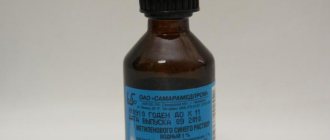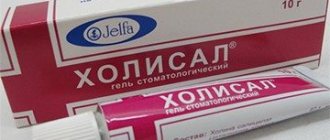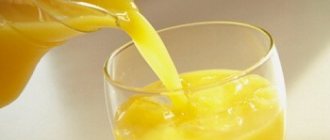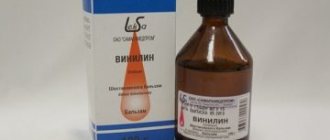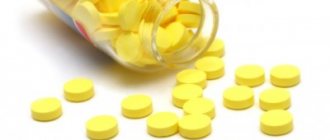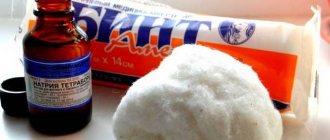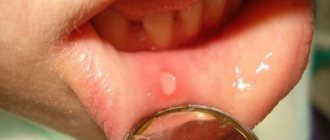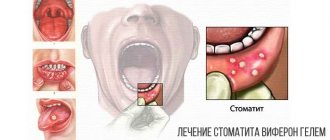Ingalipt – a combined aerosol drug with a wide range of therapeutic effects: antimicrobial, anti-inflammatory, analgesic. In the preparation, the antibacterial properties of sulfonamides are harmoniously combined with the healing capabilities of a number of medicinal plants. Intended for the treatment of infectious and inflammatory diseases of the oral cavity and upper respiratory tract in adults and children over 3 years of age. Local action causes minimal side effects. Convenient to use. Produced since 1969. It has been in demand all these years.
Composition of Lugol
Lugol contains the following components:
- iodine;
- glycerol;
- potassium iodide
The main active ingredients are potassium iodide and iodine, which are soluble in glycerin.
The drug was originally created by Jean Lugol in 1829, but not to treat stomatitis, but to combat pulmonary tuberculosis. After some time, doctors realized that Lugol's with glycerin was not suitable for combating tubercle bacillus, but they appreciated the ability of this remedy to treat infectious and inflammatory diseases of the skin and mucous membranes.
How to use and dosage
Use "Lugol" like this:
- The spray is applied to the inflamed mucous membrane up to 6 times a day, or a cotton swab is moistened with the solution and the wounds are treated with it.
- When spraying the spray, the patient should hold his breath so that iodine does not enter the respiratory tract.
- After use, the sprayer does not need to be removed from the bottle so as not to stain its end and disrupt the spray system.
- Doctors advise completing the entire course of treatment with the drug, even if the symptoms of the disease have passed.
Before using the drug, you must clean your mouth.
It must be remembered that pus, acidic or alkaline conditions, blood and fat reduce the activity of Lugol, therefore the use of the drug for some types of ailments at an advanced stage is not advisable. When using the medication, you must not consume certain foods that create an acidic environment on the mucous membranes or contain a lot of fat.
Before using the medicine, the mucous membrane must be rinsed with herbal infusion. Calendula, sea buckthorn, chamomile, sage, and oak bark are suitable for this purpose. You can use soda, Furacilin tablets, but in no case should you use Chlorhexidine for these purposes, since it, in combination with Lugol, can cause a severe allergic reaction. And also you cannot use the drug for stomatitis together with peroxide and essential oil.
This is interesting: How fissure sealing is performed in children
Mechanism of action of Lugol's solution
The effect of Lugol's solution on stomatitis is antimicrobial. Potassium iodide enhances the properties of iodine. All active ingredients, when they come into contact with the mucous membrane, primarily have an antiseptic effect and kill most microbes. In case of stomatitis, this is very important, since if pathogenic microorganisms actively multiply in the oral cavity, the risk of infection and the development of an ulcerative-necrotic form of the disease increases sharply.
Iodine is a universal bactericidal substance and has a negative effect on both gram-positive and gram-negative microbes. Upon contact with the mucous membrane, it turns into iodide and has a bactericidal effect. Additionally, it has the ability to resolve infiltrates and moderately irritate tissue.
Terms of use
In order for the product to have the maximum effect in eliminating stomatitis, it is necessary to take into account all the rules for its use.
The procedure for treating mucous membranes should be carried out no less than 30 minutes after eating.
Several methods are used to treat the affected surface :
- Lubricating the inflamed area with a swab containing Lugol's solution. To do this, it is necessary to form a small cotton or gauze swab, which is moistened with the drug and treated with it the oral mucosa.
- Spot treatment of mucosal ulcers and rashes.
To do this, you can wrap a small piece of bandage around your finger and treat the rash. To make this procedure easier, it is recommended to use a pencil or stick with cotton wool wrapped around it. Then, the resulting structure is dipped in Lugol's solution and the product is applied to each ulcer.
In order to properly treat the inflamed areas, it is necessary that the liquid drips a little from the cotton wool. Spend no more than 2–3 seconds on each section. After 3 minutes, you can repeat the procedure.
Up to 3 such treatments can be repeated in one session.
Maximum effectiveness can be achieved if you smear the affected areas every 5 hours for stomatitis in a child, and every 3 hours when treating stomatitis in an adult.
During application of the liquid, a strong burning sensation may be felt, which disappears as the inflammation subsides.
Lesions that occur on the lips are treated using the application method . To do this, form a small flat disk from cotton wool or a bandage, which is heavily moistened with Lugol.
The disc is applied to the affected area for at least 20 minutes. This method of treatment is most often used to relieve stomatitis in adults. No more than 3 applications are allowed per day.
Due to the presence of iodine in the composition, Lugol has a pronounced odor, which, even when applied topically to the mucous membrane, causes a gag reflex.
In this case, it is recommended to use the drug in the form of a spray .
The inflamed mucosa is irrigated 4 to 6 times a day at equal intervals. For the procedure, you need to point the sprayer at the problem area and press on it. To treat the oral cavity of children, 1 click is enough.
For adults, 2-3 sprays are allowed. Irrigation should be carried out after holding your breath and without touching the mucous membranes with the spray.
The Lugol treatment procedure should be carried out over 3 days. A repeated course is allowed only with an interval of 3 days.
How to use Lugol and other home remedies for stomatitis, watch the video:
This is interesting: Instructions for using Foredent filling material in dentistry
Main indications for use
Lugol is prescribed for any inflammatory processes of the skin and mucous membranes. The product is used for tonsillitis and other ENT diseases, stomatitis, skin burns, trophic ulcers. The main purpose of the drug is tissue disinfection.
If you suppress the infectious process in time, you can reduce the signs of stomatitis and prevent complications.
You can find a photo of what stomatitis looks like in the mouth on our website.
Despite its wide availability, Lugol for stomatitis should be prescribed by a dentist. Iodine can cause a local allergic reaction and further irritate the mucous membrane. The drug is used especially carefully to treat stomatitis in a child. Read the instructions carefully and consult your doctor first.
In what cases are sprays prescribed for stomatitis?
Sprays for stomatitis, unlike sea buckthorn oil, are good because they act only locally, and they work as quickly as intravenous agents.
Their small particles quickly penetrate the mucous membranes and the most inaccessible areas of the mouth. This material will tell you about the symptoms and treatment of stomatitis in the throat. Such remedies are also good because they make it easier to regulate the dosage of the medicine. Their formula increases the activity of the active ingredient. Sprays are reliably protected from bacteria thanks to their sealed packaging; they provide excellent pain relief and disinfection. They are prescribed only by a dentist.
Sprays are prescribed in the following cases:
- for bacterial stomatitis caused by aerobacteria, streptococci, staphylococci, etc.;
- with traumatic stomatitis;
- for candidal stomatitis;
- in case of hypersensitivity to any substance (using it in the form of a spray minimizes side effects);
- in the initial stages of stomatitis on the lip and oral mucosa;
- for pain in the oral cavity;
- in combination with other drugs.
Sprays for stomatitis, unlike sea buckthorn oil, are good because they act only locally, and they work as quickly as intravenous agents. Their small particles quickly penetrate the mucous membranes and the most inaccessible areas of the mouth. This material will tell you about the symptoms and treatment of stomatitis in the throat.
Adults are generally prescribed medications according to indications and desired effect. That is, the funds must have:
- Anti-inflammatory;
- Painkillers;
- Cleansing;
- Moisturizing;
- Decongestant;
- Regenerating effect.
This group of drugs belongs to antibiotic sprays. Their active component is hecatidine, which shows excellent effectiveness against bacteria, viruses, and fungi.
An effective product that contains antibiotics
The products are equipped with a convenient nozzle that will allow you to treat specific areas. This type of medication is considered almost safe, which is why it is used during pregnancy and in pediatrics.
Follow the link for instructions for use with Stopangin spray.
Ingalipt
Most often used in therapy, which will allow you to cope with the disease much faster
It contains sulfonamide bonds, and, therefore, is also a local antibiotic, which is effective even against those pathogens that have developed resistance to other groups of antibacterial agents.
Derinat
This medication belongs to the group of immunomodulators, but in addition it has good anti-inflammatory, antiallergic, and antitumor agents. Based on sodium deoxyribonucleate.
The product has a full range of antiviral properties, which will allow you to quickly cope with the disease and reduce pain.
It also has an antioxidant and detoxifying effect. Helps strengthen local immunity and enhance its work.
This group of drugs is based on iodine. A powerful antiseptic copes well with pathogens - from viruses to fungi, and helps speed up tissue healing. But in some cases it can cause an allergic reaction. Read how to gargle with Iodinol.
Should be used only as prescribed by a doctor
Kameton
Cameton is also a domestic drug that has long been familiar to many. Contains essential oils and chlorobutanol. The taste has a specific, bitterish, with a pronounced minty smell.
Although the product has a specific taste, it is still worth using, especially since it can quickly relieve pain
Helps cope with pathogens, reduces inflammation, facilitates breathing and reduces sore throat. Like Ingalipt, it is a budget option for the treatment of nasopharynx and inflammatory and infectious pathologies of the throat.
Miramistin
Miramistin is the No. 1 antiseptic according to modern doctors. It is active against a wide variety of pathogens, from herpes, influenza and HIV viruses to chemotherapy-resistant fungi.
A very effective remedy and most often used in the treatment of various viral diseases
It has no taste, odor or coloring properties, and therefore can be easily used literally everywhere. It can be safely used by pregnant women, young children and breastfeeding mothers. Before use, you must read the instructions and read about how to use Miramistin for the throat.
Novosept
Novosept is a medicine originally from Holland. It has no analogues in composition. It contains 3 active components that have antiseptic, immunomodulatory and anesthetic effects. The composition contains an antibiotic. It must be used every 2 hours.
The product contains antibiotics which will allow you to quickly cope with inflammation.
It has a number of contraindications and incompatibilities with other medications. Often causes irritation of mucous membranes. Therefore, before use, you should carefully study the instructions.
Anti-angina
A very popular product among consumers, since the product has active substances and is not very expensive
Due to the lack of an immunomodulatory effect, it is less effective than the previous medication, but also costs less.
We suggest you read: Fluconazole for stomatitis in the mouth
Octenisept
Octenisept is an antibiotic for topical use. It has a spray bottle (note that there is also a solution that is sold in a regular bottle and does not have a special nozzle). The active components are phenoxyethanol and octenidine.
This remedy can be used by both adults and children, but the latter should consult a doctor
Propolis and Proposol
These are preparations based on bee products. Such medications are classified as apitherapy. They promote wound healing, eliminate inflammation, and also actively fight bacteria.
This remedy is very active in effective wound healing.
In addition, propolis is a natural immunostimulant. The problem is that if you have a food allergy, especially to bee products, you should not use such products.
Chlorophyllipt
A drug that is produced in Ukraine. The active component is eucalyptus extract and more. Shows a narrowly targeted effect against staphylococci. The specific mechanism of action has not yet been fully elucidated, but in fact it turns out that the medication has anti-inflammatory, wound healing and irrigating effects. Be sure to read the instructions for using Chlorophyllipt gargling.
The product has an active anti-inflammatory agent with quick healing results
How to use Lugol for stomatitis
Lugol can be used in several ways:
- spot treat areas of inflammation and ulcers using a cotton swab or a piece of sterile bandage;
- treat the entire mucous membrane with a gauze napkin using gentle blotting movements;
- irrigate the mucous membrane with Lugol in the form of a spray;
- rinse your mouth with boiled water to which Lugol's solution has been added.
You can use one or several methods of antiseptic treatment of the oral cavity using Lugol. The product combines well with other antiseptics and antimicrobials, both local and systemic.
But it is not recommended to combine several dosage forms at once - it is better to maintain an interval of 1-2 hours.
What other medications are there for stomatitis, read on our website.
Local antiseptic treatment of the oral cavity with Lugol for stomatitis begins as early as possible, when the first signs of the inflammatory process appear. The drug is available in the form of a solution and spray. Choose a form that is convenient for you.
When treating children, it is better to use Lugol's solution. For stomatitis, it is applied to sterile gauze and applied pointwise to areas of inflammation of the mucous membrane. The spray in childhood can provoke bronchospasm, especially if stomatitis develops as a complication of ARVI, bronchitis or ENT diseases.
The drug is used at least 4-6 times a day. It is important to use other local remedies in the form of ointments and solutions. An integrated approach to treatment guarantees rapid elimination of the inflammatory process with minimal risk of complications.
How to properly organize the treatment of stomatitis in the mouth at home, read on our resource.
The duration of use of Lugol for stomatitis depends on the severity of the clinical manifestations of the disease. If you start taking local remedies at an early stage, 5-7 days of treatment is enough. In the case when Lugol does not alleviate the condition and the inflammatory process progresses further, it is necessary to consult a dentist as soon as possible to correct the prescribed treatment.
Video:
Medicines for stomatitis - TOP-11 drugs for treatment
Hexoral against stomatitis
The drug Hexoral is often used to treat stomatitis. It is effective for both herpetic and fungal manifestations of the disease. In addition, the pharmaceutical product is also used for the treatment of other oral ailments. Despite the effectiveness of use, the drug has side effects, so before starting a course of therapy you should consult a specialist.
Composition and release form
The pharmaceutical product is produced in the form of a solution, aerosol, tablets and lozenges. The active component of all release forms is hexethidine. Additional components of the solution are anise oil, citric acid monohydrate, polysorbate and sodium saccharin.
The aerosol contains the following excipients: eucalyptus leaf oil, purified water, sodium saccharinate. The solution is supplied in 200 ml bottles, which are located in cardboard packs. The aerosol is placed in 40-milliliter cans, packed in cardboard boxes along with a sprayer.
Hexoral tablets are supplied in blisters of 10 pieces.
Indications for use
The instructions for use say that Hexoral is prescribed for the treatment of the following conditions:
- diseases of the oral cavity of an infectious and inflammatory nature;
- inflammation of the tonsils;
- damage to the mucous membrane and lymph nodes of the oral cavity;
- gingivitis;
- bleeding gums;
- stomatitis;
- superinfection;
- fungal infections of the oral cavity, including candidal stomatitis;
- after surgical interventions in the oral cavity;
- preventive measures to get rid of unpleasant odor from the mouth.
Lollipops and tablets
The treatment regimen is determined by the attending physician.
The instructions for using Hexoral for stomatitis say that the use of lozenges and tablets is unacceptable in children under 6 years of age. Upon reaching this age, children and adult patients should dissolve 6 tablets throughout the day.
It is important to note that in a 2-hour period it is permissible to take no more than 1 piece of the described medication. The exact dosage and duration of use of the medicine for stomatitis is determined by the attending doctor, depending on the severity of the disease and the characteristics of the patient’s body.
Hexoral solution
The medicine "Hexoral", which is presented in the form of a solution, is used locally.
The pharmaceutical product should be used to wipe the mucous membranes of the oral cavity using a cotton pad previously soaked in the medicine.
It is important to prevent Hexoral from entering the gastrointestinal tract during processing. You will need to apply the pharmaceutical preparation 2 times a day after eating.
In some situations, it may be necessary to increase the dosage, which only the treating specialist has the right to do.
Spray "Hexoral" in the treatment of stomatitis
Spicy foods irritate the oral mucosa.
Hexoral spray for stomatitis should be sprayed onto the affected areas of the oral cavity for 2 seconds. After treating your mouth for a few minutes, it is important not to swallow saliva. They resort to using pharmaceuticals 2 times a day.
However, the correct dosage and duration of treatment is determined by the doctor.
In addition to using Hexoral, the doctor may prescribe the use of medications that help strengthen the immune system, and a special diet from which food that irritates the affected areas of the oral cavity will be excluded.
Using Hexoral for children
The pharmaceutical product "Hexoral" in the form of both a solution and a spray is not prescribed to small patients who have not reached 3 years of age.
Such precautions are due to the fact that the medication can only be prescribed at an age when the child is already able to consciously rinse his mouth and not accidentally swallow the solution.
As for the Hexoral spray, the child must understand that while injecting the spray, you need to hold your breath. Upon reaching the age of three, treatment with Hexoral can be carried out after consultation with a pediatrician.
Contraindications and side effects
There may be a slight decrease in the sensitivity of taste buds.
The instructions for use say that Hexoral is not prescribed for stomatitis when the patient has an individual intolerance to individual components in the pharmaceutical composition, as well as for children under 3 years of age.
Doctors note that the occurrence of side symptoms is quite rare and patients often tolerate the medicine well. In exceptional situations, individual sensitivity to the components of the medication may appear, as well as the sense of taste may be impaired.
Analogues of "Gexoral"
Since Hexoral for stomatitis is not suitable for all patients due to contraindications, doctors replace it with analogue medications that have a similar mechanism of action on the body. For these purposes, the following pharmaceuticals are used:
- "Stopangin";
- "Stomatidin";
- "Hexethidine."
It is important to note that self-medication of stomatitis is prohibited, especially in a child.
Doctors note that independently replacing the prescribed Hexoral with similar medications is fraught not only with not getting rid of stomatitis, but also with harm to your overall health.
If you suspect a disease of the oral cavity, it is important to go to the hospital, where a specialist will conduct the necessary diagnostics and only after that will prescribe the most effective and safe medication that is suitable for a particular patient.
Conditions for dispensing and storing medications
You can buy Hexoral for stomatitis without a prescription from a specialist.
As stated in the instructions for use, the product should be stored in a dark room, the temperature in which will not rise above 30 degrees Celsius.
The place where the medicine is stored should not be exposed to direct sunlight or children. The shelf life of the medicine is 2 years, and when opened it is six months.
Source: https://EtoHerpes.ru/stomatity/preparaty/geksoral-pri-stomatite.html
Contraindications
Lugol's contains iodine, which is a rather aggressive component and can cause even greater irritation of the mucous membrane. Therefore, the drug is not used for severe dry mucous membranes.
Other contraindications:
- iodine intolerance;
- pregnancy;
- excess iodine content in the body;
- a pronounced inflammatory process, which is accompanied by the formation of massive ulcers and boils.
With caution, Lugol for stomatitis is used for kidney and liver diseases in the stage of decompensation, thyrotoxicosis.
When is it prescribed?
The product effectively eliminates the inflammatory process at the initial stage.
Spray or solution "Lugol" is used for inflammation of the mucous membranes caused by infectious or fungal infections in adults and in rare cases in children. In case of severe inflammation, suppuration of wounds and high temperature, the drug does not cope, so it should be used at the initial stage of the disease. The product is effective for diseases such as:
- stomatitis;
- jams;
- tonsillitis;
- angina;
- otitis;
- rhinitis.
This is interesting: Blisters and bubbles on the tongue in adults and children: at the root closer to the throat, red, white
Possible side effects when treating stomatitis
Lugol is intended for external use. If you follow the rules set out in the instructions, the risk of adverse reactions will be minimal. The following complications may arise:
- increased inflammatory process as a result of irritation of the mucous membrane;
- allergic reactions;
- dry mouth;
- increased activity of the thyroid gland;
- drowsiness, decreased performance.
The most common adverse reaction is individual intolerance to the drug. If you have not used topical iodine products before, it is recommended to do a sensitivity test on the inside of your wrist the first time you use it. Apply a few drops of the product to the skin and leave for 20 minutes. If after this time no signs of inflammation appear, then the drug is suitable for you and can be used to treat stomatitis.
The use of Iodinol for stomatitis is also common, you can find out about this in our article.
Some people make the mistake of applying Lugol too liberally to damaged oral mucosa or leaving napkins soaked in the drug on ulcers and areas of inflammation. Doing this is strictly prohibited. Lugol should not be applied to the mucous membrane under bandages and napkins, as this will lead to severe irritation and may even contribute to the formation of deep ulcerative defects.
Pharmacodynamics
The release form of the drug ensures its targeted action, due to which the medicinal substances quickly reach the affected area, even when it is located in hard-to-reach parts of the oral cavity. Inhalipt spray, when refilled, guarantees high dosage accuracy, which means economical use of the medicine.
The sulfanilamide and sulfathiazole contained in Ingalipt disrupt the synthesis of enzymes of microorganisms that cause diseases of the oral cavity and pharynx, as a result of which their growth and reproduction stops. Ulcers, accordingly, heal and do not cause complications. At the same time, the possibility of spreading the inflammatory process to healthy areas of the oral cavity is stopped. The antimicrobial effect of sulfonamides is enhanced by powerful natural antiseptics - thymol, eucalyptus oil, peppermint oil.
Glycerol, having osmotic properties, sucks out excess intercellular fluid from tissues, which helps cleanse the affected areas of pus and bacterial plaque. Anesthetics – eucalyptus oil and peppermint oil quickly relieve pain, cool and soothe.
As a result, the use of Inhalipt leads to the disappearance of symptoms of stomatitis, including intoxication ones, an improvement in the general well-being of the patient and a reduction in recovery time.
We suggest you read: Stomatitis in a child’s mouth, treatment at home
Pharmacokinetics
The active substances of Inhalipt have a limited effect, mainly at the site of inflammation, in fact, pointwise, are poorly absorbed, and therefore do not have a systemic effect on the body.
Sulfanilamide substances bind to blood proteins (streptocide is 12–14% soluble, sodium sulfathiazole is 55%), converted to acetylated forms and excreted by the kidneys. The half-life of sulfanilamide is 10 hours, sodium sulfathiazole is 1-2 hours after administration.
What can replace Lugol's solution?
Lugol for stomatitis has good analogs that also contain iodine. One such drug is Yox. It is used not only for stomatitis, but also for throat diseases. Yox causes a strong burning sensation after application, which indicates the aggressiveness of the product. Lugol's effect is gentler, so it is preferable, especially in children's practice.
At home, you can independently prepare an analogue of Lugol’s based on iodine, soda and salt. Mix a tablespoon of soda with a teaspoon of salt and 5-7 drops of iodine, add 50 g of warm boiled water. The resulting composition is used to rinse the oral mucosa. You can apply this home remedy to the inflamed areas for a few minutes using a napkin, and then rinse with boiled water.
You can replace Lugol with any modern antiseptic (Miramistin, chlorhexidine). Even ordinary boiled water, in which a few drops of iodine are pre-dissolved, is suitable for rinsing the mouth.
How Chlorhexidine is useful for stomatitis, how to rinse inflammation with it, read here.
An analogue of Lugol's in composition is the drug Betadine. It is produced in the form of a solution and ointment. The active component is povidone-iodine, the properties of which are complemented by macrogol. The drug is used to treat the mucous membrane several times a day. Betadine's cost is several times higher than Lugol's solution; its price is within 250 rubles.
Aquazan, which is available as a solution for topical use, also contains povidone-iodine. The drug has an antiseptic effect, helps destroy infectious pathogens and has an affordable price - only 60-80 rubles.
Dentamed is also an analogue of Lugol's action. It includes the presence of chlorhexidine and metronidazole, and therefore has a pronounced antimicrobial effect. The drug is applied to the inflamed mucous membrane 2 times a day. The duration of treatment is on average a week.
If Lugol's is not available for stomatitis, you can use special lozenges with antiseptic substances. An example of such a remedy is Laripront. Tablets can be used to treat stomatitis in adults and children every 2-3 hours. They destroy infectious pathogens, prevent worsening signs of stomatitis and significantly improve your well-being.
Description of the drug
Hexoral is a drug that has antimicrobial, analgesic, antiseptic and hemostatic effects.
The active substance of the drug is hexeditin.
The analgesic effect is felt within a few minutes after taking the medicine, and lasts for 12 hours.
Reference! Due to the fact that Hexoral is not absorbed into the blood, it is allowed to be used by women carrying a child and during breastfeeding, but only with a doctor’s prescription.
The drug penetrates into the deep layers of mucous tissue to the source of infection, reduces the sensitivity of nerve receptors, relieves pain, eliminates white plaque from ulcers and accelerates the process of regeneration of damaged tissues.
Reference! The drug has a deodorizing effect, which helps eliminate the specific putrid odor from the mouth that accompanies stomatitis.
Hexoral does not react with other medications. There have been no cases of overdose with spray aerosol in medical practice.
The drug Hexoral has the following release forms:
- Spray aerosol in a metal bottle with a volume of 40 ml.
- Solution in a glass bottle 200 ml.
- Hexoral Tabs lozenges and tablets are packaged in blisters of 10 pieces. One cardboard package contains 2 blisters.
The most popular form of release and the most convenient for the treatment of childhood stomatitis. The drug irrigates inflamed mucous membranes. Usually 1-2 sprays are enough.
The spray reduces pain and relieves inflammation. Includes:
- Menthol.
- Peppermint essential oil.
- Eucalyptus essential oil.
- Lemon acid.
- Hexitin.
It is important to ensure that the child does not swallow the drug, otherwise this may lead to laryngospasm. For this reason, the spray is not used to treat children under three years of age. Children do not know how to hold their breath while irrigating the mouth.
Important! If allergic skin rashes or any other side effects appear while taking the drug, you should immediately stop using the product and replace it with an analogue.
This form of release is inferior in popularity to spray and tablets. Used as a spot treatment for inflammation or as a mouth rinse.
The solution has a red tint and a strong peppermint aroma. Includes:
- Ethanol.
- Peppermint oil.
- Anise oil.
- Clove oil.
- Eucalyptus oil.
- Lemon acid.
- Levomenthol.
Rinsing with a solution is prescribed for the treatment of stomatitis, pharyngitis, sore throat and inflammatory diseases of the oral cavity of fungal or bacterial origin.
Reference! The solution is often used to treat the throat or mouth after surgery.
One serving of rinse is 15 ml (about 1 full tablespoon). The solution is used twice a day - after waking up and before going to bed.
The high effectiveness of the tablets is due to the presence of active substances in them - chlorhexidine and benzocaine. They destroy pathogenic microorganisms and are able to quickly relieve pain.
Hexoral tablets
Long-term use of lozenges can reduce the sensitivity of taste buds and cause a feeling of numbness in the mouth.
Reference! The tablets have no contraindications for pregnant and lactating women, however, the drug should be taken with caution and under the supervision of a doctor.
Hexoral shows high effectiveness in the fight against herpetic and fungal stomatitis.
- Solution – applied twice a day after meals. To do this, you need to moisten a cotton swab or gauze in the solution and apply it to the inflamed area for 30 seconds. Also, rinse the throat and mouth for 1 minute twice a day.
- Spray - distributed onto inflamed areas of the mucous membrane using 1 or 2 irrigations. At this point, it is important not to inhale or swallow saliva. The duration of the course may vary depending on the severity of the disease.
- Tablets - adults and adolescents over 12 years of age are prescribed 6 to 8 tablets per day.
Reference! In addition to Hexoral, for the treatment of stomatitis, doctors often prescribe immuno-strengthening drugs and a special diet that excludes spicy, salty and sweet foods in order to prevent additional irritation of the inflamed areas.
Analogs
An alternative to Lugol based on the principle of influencing the affected areas of the mucous membrane are drugs such as:
- "Sore throat";
- "Hexoral";
- "Anzibel".
Analogues of the active ingredients are:
- "Yox";
- "Polyvidon".
Betadine
A product with disinfectant and antiseptic properties. Quickly stops the effect of all gram-negative and -positive bacteria (except Mycobacterium tuberculosis), is effective against viruses, fungi and protozoa.
Available in two forms - ointment and solution. The main compound is povidone-iodine (100 ml is present in 1 ml of the drug). Excipients : citric acid, glycerin, nonoxynol, sodium hydroxide.
Prescribed for treatment up to three times a day in an undiluted state.
The approximate cost of the medicine, regardless of the form of release, is about 260 rubles.
Aquazan
10% solution exhibiting antiseptic, dehydrating, disinfecting effects. The product has extensive antimicrobial effects , i.e. active against fungi, bacteria (even affects tuberculous mycobacteria), protozoa, viruses.
The active substance is povidone-iodine , the auxiliary substances are water and sodium trisubstituted phosphate.
Use up to three times a day diluted or without dilution.
The average price for Aquazan is 55 rubles.
Dentamet
Dental gel for local use with a combined antimicrobial effect. It is analogous to Lugol only in action. Produced in tubes of 25 g and 10 g.
Active active compounds are metronidazole (100 mg - 1 mg) and chlorhexidine 20% (0.5 mg per 100 mg product). Auxiliary ingredients: glycerol, levomenthol, dihydrated sodium saccharinate, trolamine.
For local use only. After treating the affected areas, it is not recommended to drink or eat food for half an hour. The gel is applied to the mucous membrane twice a day, the course of treatment is 7-10 days.
The average cost of Dentamet is 150 rubles.
Strepsils
A combined antiseptic, produced in lozenges, used to treat infectious and inflammatory diseases.
It has an active effect on microbes and fungi, affects all gram-positive and negative microorganisms.
The main components are amylmetacresol (0.6 mg) and 2,4-dichlorobenzyl alcohol (1.2 mg). Additionally, ascorbic acid, lidocaine, eucalyptus oil and flurbiprofen can be added to the composition.
Sold in packs of 1-2 blasters of 4 tabs, 6 tabs, 8 tabs. and 12 tab. Apply only topically every 3 hours for no more than 3 days.
Important: the permissible daily intake of tablets should not exceed 8 pieces.
Based on the number of tablets in a pack, the cost can vary from 200 rubles. up to 430 rub.
Metrohex
The drug is in the form of a gel for local use with antimicrobial action. Its effectiveness is determined by the presence of metronidazode (16 mg) and chlorhexidine (500 mcg), as well as sodium saccharinate, butylated hydroxyanisole, butylated hydroxytoluene, polysorbate, and trolamine.
The composition is active against anaerobic bacteria and protozoa due to the presence of metronidazole. It acts on vegetative forms of gram-positive and -negative microorganisms, yeast, viruses and dermatophytes due to the content of chlorhexidine.
The product is applied to the affected areas three times a day for up to 7 days.
Produced in aluminum tubes of 10 g. Approximate cost - 140 rubles.
Side effects
With prolonged use during the treatment of stomatitis, exceeding the dose or suddenly developing intolerance to the drug, the following adverse reactions may occur:
- insomnia;
- tachycardia;
- nervousness;
- hives;
- acne and acne;
- swelling;
- tearfulness;
- diarrhea;
- constipation;
- rhinitis;
- swollen lymph nodes;
- rash;
- sweating;
- respiratory tract burn;
- hemolysis;
- laryngospasm;
- intoxication;
- hemoglobinuria.
